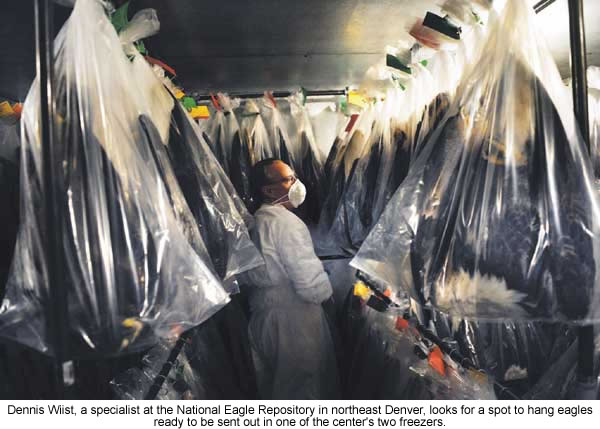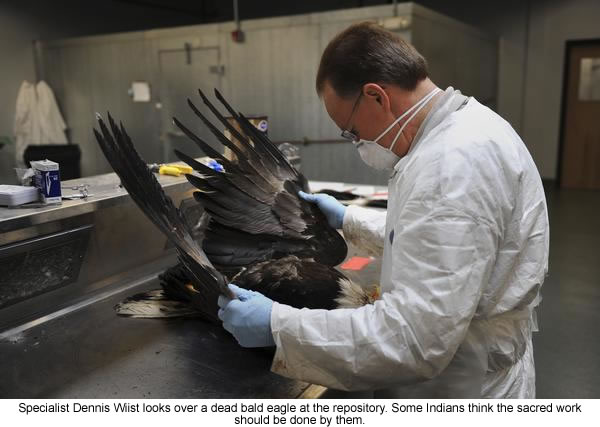 |
Canku Ota
|
 |
|
(Many Paths)
|
||
|
An Online Newsletter
Celebrating Native America
|
||
|
October 1, 2009 - Volume
7 Number 10
|
||
|
|
||
|
Eagle Bodies, Parts
For Indian Rites Are Collected, Sent From Colorado Morgue
|
||
|
by Electa Draper - The
Denver Post
|
||
|
credits: photos by Joe
Amon - The Denver Post
|
|
For
some Americans, practicing their religion requires a federal permit
and a long wait for a controlled substance — eagle parts.
The National Eagle Repository, Building 128 at the Rocky Mountain Arsenal, is a one-of-a-kind religious-supply house that processes about 2,000 dead golden and bald eagles a year for American Indian rituals. Under the Bald and Golden Eagle Protection Act of 1940 and amendments, an eagle may not be taken or killed — not even a loose feather may be picked up. Only dead eagles can be salvaged — and only by the federal government. The bald and golden eagles at the northeast Denver repository have been found dead in the wild, or they come from zoos or licensed rehabilitators. "The majority are in bad condition," said supervisor Bernadette Atencio. "These birds come in from all over the country. These birds go out to all over the country." A two-person staff fills orders for the feathers, heads, talons and whole eagles used by many of the 500 federally recognized American Indian tribes. About 6,000 orders are waiting to be filled at the repository, Atencio said. "There is a lot of red tape for Native Americans to practice their religion using eagles. It is a very big hindrance," said Myron Pourier, a cultural-affairs official with the South Dakota Oglala Sioux tribe, or Lakota. Demand for the limited supply of eagles is high, especially among Plains, Navajo and Pueblo Indians. "The repository takes a bad rap because of the time it takes to fill an order," Atencio said. "A lot of people don't realize how much work we do to fill an order." An American Indian who requests a whole bird can wait up to four years after getting a permit. The wait for 10 loose, high- quality feathers is typically six months.
Seen
as an elder brother The eagle is used in healing and in strengthening ceremonies for warriors, including soldiers in Iraq and Afghanistan. After Indians have received an eagle, they give it a proper blessing — a show of gratitude for its gifts — before sending it on to the spirit world, Pourier said. Before an Indian, who must be 18 or older and enrolled in a federally recognized tribe, can order an eagle or eagle parts, he or she must obtain a permit from their state of residence's Migratory Bird Permit Office. The Colorado office is in Lakewood. Getting a permit, which is good for a lifetime, can take months or even years. "Everyone in Indian Country agrees the whole process needs to be streamlined," said Don Ragona, an attorney with the Boulder-based Native American Rights Fund. "It's an outrageously long wait." At the national repository, the small staff must work within the law and a small budget. The biggest demand is for immature golden-eagle feathers, which are white with black tips. The repository does not examine the birds it receives for a cause of death. If the West Nile virus is suspected, the bird is not sent to the repository. The staff does not remove maggots or otherwise clean the birds. The recipients do that. The two specialists who work in the eagle program lay the birds out on stainless-steel tables and examine them from head to claw for usable parts. Whole wings and tails may be used in fans. Tiny ulna bones are sometimes used as whistles. Small pinfeathers might be used on Hopi kachina figures or placed in medicine pouches. 30
birds shipped a week They make 100 to 150 shipments of loose feathers a week. They might ship 30 whole eagles a week. "It's piece work, really," Atencio said. "Some just want the tails. Some just want the wings. A lot of people are holding out for the perfect whole bird. Perfect is hard to come by." Seeing the national symbol, with a wingspan of up to 8 feet, processed something like poultry is unsettling for some. The clinical approach to handling the birds disturbs many American Indian applicants. "We hear that a lot," Atencio said. "They will ask us if we're Native American. They feel Native Americans should be doing this work here. But anybody can do this job. We have our protocol. Our staff is sensitive." The repository, Atencio said, works with all types of American Indians, from traditionalists, whose primary concerns might be with blessing and ceremonial burial of the eagle, to modern tribal members, whose concerns are often about the aesthetics of the regalia for dances. "These birds mean a lot to them," Atencio said of the applicants. "You know that just by talking to them on the phone. They are sincere and humble about what they're asking for."
Why
the repository? No one — not even American Indians — can sell or barter any part or anything made from eagle parts. They can make a gift of it, or bequeath it upon death, but only to other American Indians. Violations of the act can result in a $100,000 fine and up to a year in prison, yet there is a thriving black market. If you find a dead bald or golden eagle, do not touch it; report it to a federal or state game official. |
|
|
||
|
|
||
| Canku Ota is a free Newsletter celebrating Native America, its traditions and accomplishments . We do not provide subscriber or visitor names to anyone. Some articles presented in Canku Ota may contain copyright material. We have received appropriate permissions for republishing any articles. Material appearing here is distributed without profit or monetary gain to those who have expressed an interest. This is in accordance with Title 17 U.S.C. Section 107. | ||
|
Canku Ota is a copyright ©
2000, 2001, 2002, 2003, 2004, 2005, 2006, 2007, 2008, 2009 of Vicki
Barry and Paul Barry.
|
||
 |
 |
|
|
The "Canku
Ota - A Newsletter Celebrating Native America" web site and
its design is the
|
||
|
Copyright ©
1999, 2000, 2001, 2002, 2003, 2004, 2005,
2006, 2007, 2008, 2009 of Paul
C. Barry.
|
||
|
All Rights Reserved.
|
||

